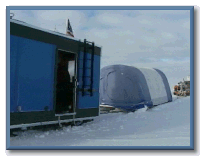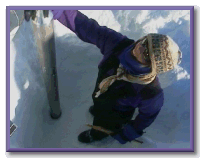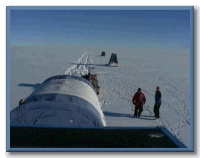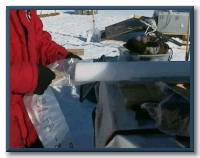Let's go behind the scenes with some home video recorded by the U.S. component of the International Trans-Antarctic Science Expedition, or "ITASE."
Long days of work, confined to close quarters, periodic challenges... it may sound like "Survivor on ice" but everyone in this group's a winner, no-one gets voted off, and everyone benefits from what they're discovering!
Their routine for the 50 days they spent in the field? Travel for one hundred kilometers, taking everything you need with you, food, computers, all pulled by tractor. These 15 researchers and support staff come from all over. Then you stop and drill. The cores go down 60-70 meters. In them are clues to what the climate of Antarctica and the planet was like as much as 200 years ago.
|
Image courtesy of |
Image courtesy of |
In these cores you find evidence of a mighty volcanic eruption from 1815, radioactivity from the Chernobyl nuclear reactor accident, even evidence of the El Niņos which warm the far-off Pacific. This continent may be remote, it's not cut off from the rest of our planet.
Out here in the field things get pretty intense, but when one of the vehicles broke down, plans changed and everyone pulled together.
|
"ITASE" takes everything it needs along with it: science lab, mess tent, sleeping accommodations. Sometimes they traveled for 36 hours straight. Some run the instruments.. others grab a bite... some sleep en route.
And that's an outhouse on skis following along. This day it kept on breaking its tow rope.
|
Image courtesy of |
Image courtesy of |
Still, all the while they roll, they're taking data. Then it's time to core some more. Even though it's very cold, the ice cores must be carefully bagged and labeled. Unusual features are noted, and then they're ready to be shipped back to Denver for detailed analysis.
As it travels the ice, "ITASE" runs 10 different kinds of experiments. 3 types of radars scan the ice, seeing more can ice cores alone.
|
|
|
To keep safe on the ice, these real-life "science survivors" make sure they've got emergency gear close by at all times, and that it's all in working order.
Many of these same researchers will be back this year. Go online to check out their journals and to follow the continuing adventures of "U.S.-ITASE" as they help us read the climate record written in the ice and snow of West Antarctica.
Websites
• ITASE
The website for the International Trans-Atlantic Scientific Expedition which includes logbooks from this year's team.
• Expedition Logbook
The day-to-day (or almost) logbook of this year's ITASE expedition to Antarctica.
![]()




